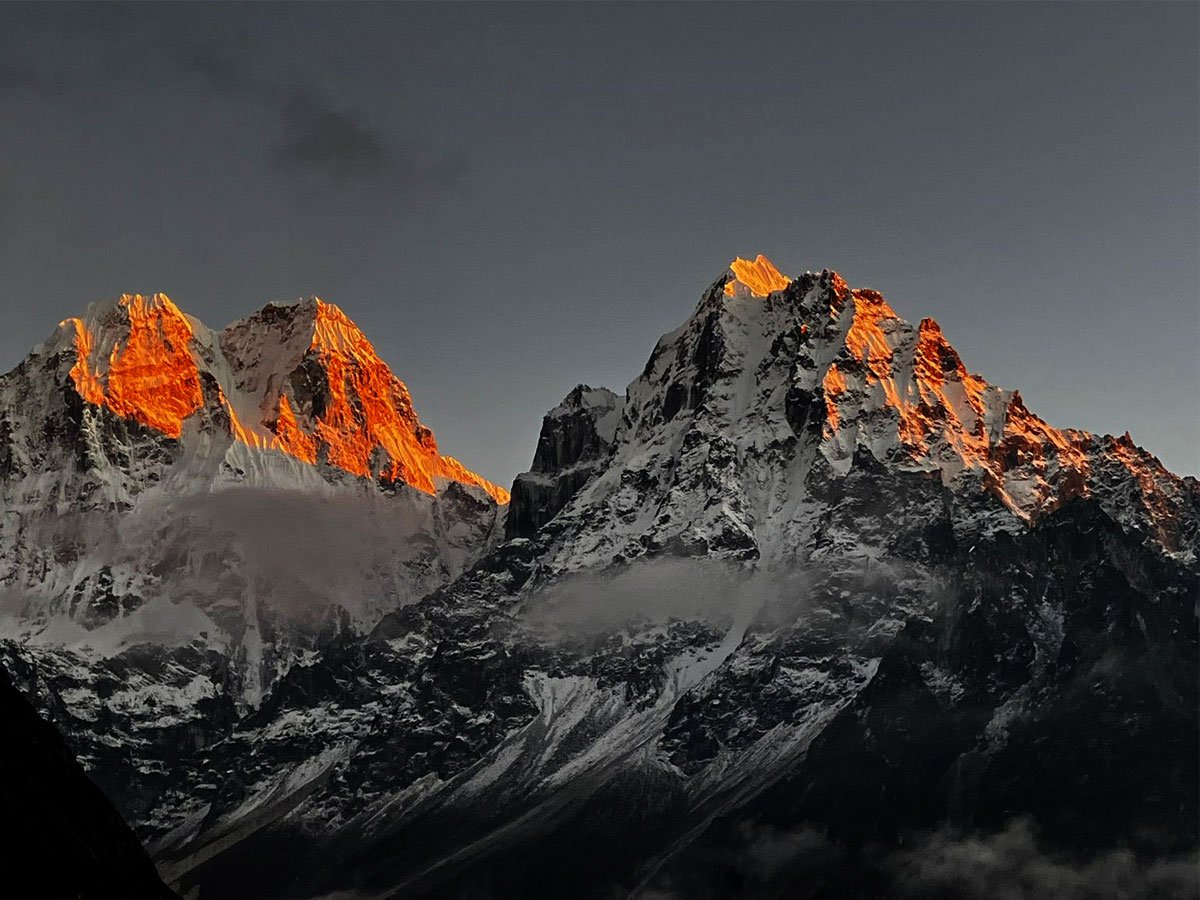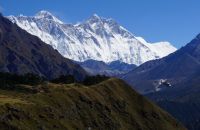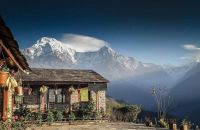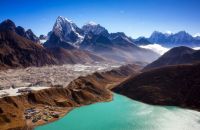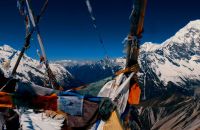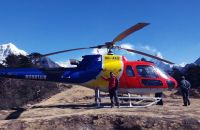Talk with our local travel specialist who can help organize your trip.
10 Things You Should Know About Kanchenjunga Trekking
Kanchenjunga Trekking, also called Kanchenjunga Circuit Trek, is the remarkable off-the-beaten-path trek that covers the eastern part of Nepal. This high-altitude trek allows you to experience the untouched and unspoiled beauty of the highland Himalayas.
But when planning a trip to a remote trekking region, there are many things you should know, such as trekking routes, permits, costs, packing lists, difficulty level, and so on. So, to make your Kanchenjunga trek more adventurous, safe, and successful, check out the top 10 things you should know about Kanchenjunga trekking.
Table of Content
- 1. Kanchenjunga Trekking Permit
- 2. Best Kanchenjunga Trek Itinerary
- 3. Kanchenjunga Trekking - How To Get There?
- 4. Kanchenjunga Trekking Cost
- 5. Best Time For Kanchenjunga Trekking
- 6. Kanchenjunga Trekking Accommodation And Food
- 7. Kanchenjunga Trekking Difficulty
- 8. Kanchenjunga Trekking Packing List
- 9. People And Culture Of Kanchenjunga Trekking Region
- 10. Solo Trip Or Guided Trip For Kanchenjunga Trekking
1. Kanchenjunga Trekking Permit
You need two permits for Kanchenjunga trekking which will cost USD 65.
- Kanchenjunga Conservation Area Permit: It will cost USD 25 per person. You can obtain this permit in Ghunsa. No photographs or prior application is required.
- Restricted Area Entry Permit: It will cost USD 20 per week or USD 40 for two weeks. You must take this permit in Kathmandu before setting off on the trek. For this permit, you need a prior application. However, you don't need to submit photographs.
Note: For Kanchenjunga North Base Camp and Kanchenjunga South Base Camp, you'll need a restricted area permit for one week, costing USD 20 per person. At the same time, Kanchenjunga Trekking will take two weeks and cost USD 40 per person.
2. Best Kanchenjunga Trek Itinerary
There are three trekking routes leading to Kanchenjunga North Base Camp, Kanchenjunga South Base Camp, or both base camps. The Kanchenjunga Trekking covers both base camps.
Kanchenjunga Trek or Kanchenjunga Circuit Trek
This Kanchenjunga trekking is the longest and hardest route among the three options. It will take 24 days to complete from Kathmandu. Unlike the famous Manaslu Circuit trek, this trek is doable clockwise and anti-clockwise. However, a clockwise itinerary is considered better than an anti-clockwise one. Because of acclimatization and the view you'll get from the North base camp (5,143m) than the South base camp (4,610m).
Kanchenjunga North Base Camp Trek
Kanchenjunga North Base Camp Trek is the second longest among the three trekking route options. This trek exclusively takes you to the North Base Camp of Mt. Kanchenjunga. It will take 15 days to complete the trek from Kathmandu. This trek route skips the challenging Selele La Pass and the Kanchenjunga South Base Camp.
Kanchenjunga South Base Camp Trek
This is the shortest among the three options, and you'll complete this trek in 14 days from Kathmandu. This route will take you exclusively to the South Base Camp while skipping the challenging Selele La, Margin La, and Sinon La Pass to Tseram and North Base Camp.
3. Kanchenjunga Trekking - How To Get There?
Most of the Kanchenjunga treks start from Taplejung, close to Suketar airport. Since this airport lies at a high altitude, flights are often canceled or delayed due to adverse weather conditions. We suggest you take a flight to Bhadrapur and drive to Taplejung or other villages like Sukethum or Mitlung, where you can start the trek.
Likewise, if you have plenty of time, you could drive to Taplejung from Kathmandu and return the same way after the trek. You can either travel on a local bus or a private jeep. However, this mode of traveling requires a few more extra days. But, it is an ideal option for those looking for a long road trip. It will also help save additional costs if you travel in a group.
Featured Trips
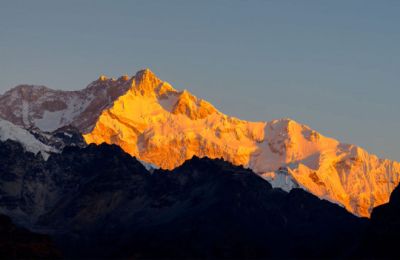
Kanchenjunga Trek - 24 days
Kanchenjunga Trek is a remarkable long remote trek into Nepal's most isolated areas of far-eastern Nepal. During 24 days Kangchenjunga circuit trek, you'll explore the area around Kanchenjunga, the third highest mountain in the world.
Inquire Now
Kanchenjunga North Base Camp Trek - 15 days
Kanchenjunga North Base Camp trek is a short trek route that leads to the popular north base camp of Mt. Kanchenjunga and lies at a higher altitude than the south base camp
Inquire NowWhere to travel next?
Get help from our travel specialists for holiday ideas that matches your interests.
4. Kanchenjunga Trekking Cost
With a mandatory guide, trekking permits, expensive domestic flights, and long trekking days in the isolated areas of the Himalayas seem more costly than other treks in Nepal.
Moreover, Kanchenjunga trekking costs will depend on the type of services, accommodation, number of trekking days, itinerary, etc. So, covering all in packages, it should range from at least USD 2000-3500 per person. The peaceful trail, incredible scenery, and unique culture you'll encounter on this route make it worth it.
5. Best Time For Kanchenjunga Trekking
Nepal has four seasons: spring, monsoon, autumn, and winter. The best time for the Kanchenjunga Circuit trek is the autumn months of October and November and the spring months of April and May.
Further, the trek starts from Bhadrapur, close to sea level, reaching the highest point, snow-covered Pangpema, at 5,143m. So, it is tough to find a balance in terms of temperature, climate, weather, and mountain views. However, we recommend doing this trek in the autumn and spring for the following reasons:
- The alluring mountain vistas include Mt. Kanchenjunga (8,586m), Kangbachen (7,902m), Mt. Kumbhakarna/Jannu Peak (7,710m), etc.
- Rainfall is rare, so there are no wet or slippery trails and risk of landslides.
- Favorable weather conditions with stable temperature.
- Spring brings a colorful ambiance along the path, spotted with lush forests, green vegetation, colorful flowers, etc.
- Since this trekking route is isolated, the trail is not overcrowded even during the peak trekking season.
Likewise, it is not advisable to trek in winter or monsoon for the following reasons:
- In monsoon, the trails are wet and slippery, and some sections between Ghunsa and Pangpema are highly exposed to landslides.
- In winter, which is from mid-December to mid-March, heavy snow will block the high Sele Le Pass.
- Also, teahouses higher above Ghunsa are closed in the winter.
Note: So, check with us when is the best time to trek Kanchenjunga.
6. Kanchenjunga Trekking Accommodation And Food
Since the Kanchenjunga trail is still developing as a teahouse trek in Nepal, don't keep your expectations high. The accommodation you'll encounter during the trek is decent, with more basic facilities. Even in some remote villages at a higher elevation, like Pang Pema and Ramche, there are only one or two places to stay. If there is a bathroom, you might have to shower with a bucket of water.
The food is expensive compared to other popular trekking regions like Everest or Annapurna. However, you'll receive plentiful and healthy food along the trail. Most of the teahouses serve the same food menu. So, at one point, you might become bored with a similar menu. Also, there are few hotels or shops along the route. It's a good idea to carry chocolates, energy bars, and snacks to keep yourself filling.
7. Kanchenjunga Trekking Difficulty
Kanchenjunga Trekking Difficulty level is graded as challenging as it is one of Nepal's long, remote, and high-altitude treks. It starts at 91m elevation at Bhadrapur and goes up to 5,143m at Pang Pema (North Base Camp). Therefore, weather conditions like temperature, air pressure, and humidity are unstable and hard to predict.
Similarly, the Kanchenjunga trek is an off-beaten path trek. The trail is extremely remote, where you have to walk most of the time on rocky terrain. So, some days are physically exhausting. So, to maintain a good level of fitness, you can participate in outdoor sports like hiking, running, swimming, cycling, etc.
Further, while trekking above 3,000 meters, there is a risk of Acute Mountain Sickness (AMS) or altitude sickness. So listen to your body, walk at your own pace and keep yourself hydrated. It is good to take advice from your family doctor about your health and fitness.
Even though the difficulty level is challenging, you don't require prior trekking experience for the Kanchenjunga Circuit trek. With enough preparation and time, anyone who is fit can do this trek.
Featured Trips

Kanchenjunga Trek - 24 days
Kanchenjunga Trek is a remarkable long remote trek into Nepal's most isolated areas of far-eastern Nepal. During 24 days Kangchenjunga circuit trek, you'll explore the area around Kanchenjunga, the third highest mountain in the world.
Inquire Now
Kanchenjunga North Base Camp Trek - 15 days
Kanchenjunga North Base Camp trek is a short trek route that leads to the popular north base camp of Mt. Kanchenjunga and lies at a higher altitude than the south base camp
Inquire NowWhere to travel next?
Get help from our travel specialists for holiday ideas that matches your interests.
8. Kanchenjunga Trekking Packing List
For the Kanchenjunga trek, you need to prepare for four seasons in one trek. The Kanchenjunga trekking elevation starts from 91meters and goes above 5,000meters. So for such altitude variations, you need to find balance with clothing. See Packing List for Trekking in Nepal
Similarly, the Kanchenjunga trek ranges from sub-tropical to alpine climates. On the clockwise route, till Ghunsa, you'll not need warm clothes. During a day hike, you can even walk in shorts and t-shirts as the average temperature is above 25-degree celsius. But once you reach Ghunsa and from there, you need to wear a down jacket as the temperature will go down even to minus, especially in the morning and night.
9. People And Culture Of Kanchenjunga Trekking Region
Kanchenjunga trekking is a unique blend of off-beaten path trek and cultural exploration in the remote Himalayan region of Nepal. It houses various ethnic groups, including Sherpas, Tamangs, Rai, Limbu, and Lepchas. Most people followed Buddhism, but you can find many other practices. The culture and lifestyle primarily reflect Tibetan culture.
In this region, most of the locals are involved in farming. While going to Ghunsa, you'll notice beautiful, terraced fields planted with wheat, barley, potatoes, and buckwheat. You can observe the alluring terrace farming on the slopes of mountains. Likewise, people are also involved in the service sector for livelihood.
10. Solo Trip Or Guided Trip For Kanchenjunga Trekking
Unlike other trekking routes in Nepal, which can be done independently, you CANNOT trek Kanchenjunga independently. It is mandatory to travel with an experienced guide. Besides, the rules also state that there need to be at least two trekkers. But this rule has a loophole, and there is a chance of getting a ghost permit. Here are some excellent reasons for hiring a guide or porter:
- A guide will organize you from transportation facilities to accommodation along the route.
- Experience guides with local knowledge will share exciting information regarding the trekking region.
- A porter will help you carry your backpack and other essential stuff for the adventure so that you can relax and enjoy your trek.
- Hiring a guide and porter will support the local economy.
Conclusion
Kanchenjunga Circuit trek is the most- preferred high-altitude off-beaten trek in Nepal. The trek to both base camps of Mt. Kanchenjunga is rewarding, and mountain views are the best in the region. If you want to challenge yourself, then plan this adventure. Before that, check out 10 things you should know about Kanchenjunga trekking before embarking on an adventure.
- Written by: Sudina Manandhar
Updated: Nov, 23, 2022

